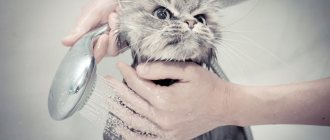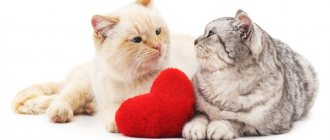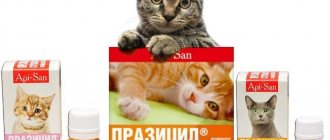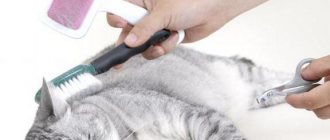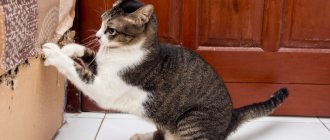Is it necessary to wash your cat?
Felines are some of the cleanest animals on the planet. They regularly lick themselves, wash themselves, tidying up their fur. Thanks to special papillae located on the surface of the cat's tongue, saliva reaches not only the top layer of fur, but also the undercoat and the skin. Thus, cats are able to remove dirt on their own and keep their coat clean.
But sometimes situations arise when you can’t do without washing. These include the following:
- the pet is very dirty;
- the animal was taken from the street;
- the cat has fleas or other blood-sucking parasites;
- the cat is participating in an exhibition where it must look perfect.
Glug-glug
Some owners wash their cats during the shedding period to speed up the process of coat renewal.
What factors determine the frequency of bathing?
How often to wash a cat, each owner decides for himself, based on his own experience. The decision is made taking into account several factors:
- pet's age;
- breed;
- health status;
- Lifestyle.
In any case, we must remember that frequent washing will not be beneficial, since, firstly, it greatly irritates the pet, and, secondly, it can negatively affect the condition of the skin.
Age
In the first months of life, the kittens are looked after by the mother, so there is no need to wash them. Until the age of three months, babies’ immunity is not yet strong, so bathing can cause hypothermia and, as a result, a cold. In addition, after washing with shampoo, the cat may not recognize the kitten by its smell and will refuse to feed it. It is acceptable to bathe a kitten for the first time after its baby teeth fall out. This usually occurs at the age of 3-4 months.
Adult animals are washed 2 to 6 times a year. Active cats, like pets who walk outside, can and should be bathed more often than calm couch potatoes, as well as older cats.
Breed
The frequency of water procedures depends on the breed of animals. Long-haired cats are washed more often (about once every 2-3 months) than short-haired cats (every 5-6 months). And breeds of hairless cats do not need to be washed at all, but wiped with a damp towel from time to time. True, most often representatives of hairless breeds, for example, Sphynxes, just love water and take a bath with pleasure.
The frequency of washing also depends on the color of the pet. Light-colored cats need to be bathed more often than dark-colored cats.
Diseases
Some diseases are accompanied by itching, which can be reduced, including with the help of a special shampoo. Hormonal imbalances and certain pathologies of internal organs cause hyperactivity of the sebaceous glands, which causes the release of an excessive amount of secretion, clogging the pores and causing hair to stick together and the appearance of tangles. You can relieve itching and at the same time tidy up the fur by washing cats with medicated shampoos that regulate the functioning of the sebaceous glands.
Place of residence
Domestic cats that do not leave the apartment are washed less frequently than pets that spend a lot of time outside. But this division is very relative.
The easiest way to determine the need for bathing is to look at the cat. An unpleasant odor emanating from shiny, sticky fur or visible dirt are clear signs that it’s time for your pet to take a bath.
Chumazik
Cat pregnancy
Any stress is undesirable for a pregnant cat, so washing is permissible only in exceptional cases, for example, if it is infected with parasites or is heavily soiled. It is necessary to bathe a pregnant cat as quickly as possible and very carefully so as not to harm the future offspring.
How to teach a cat to bathe
Cats accustomed to bathing from childhood tolerate the procedure calmly.
You should take care that your pet is not afraid of water even in his childhood. An animal should be accustomed to bathing gradually, starting with periodic washing of its paws. Everything should take place without haste and fuss - the procedure should remain in the cat’s memory as something harmless.
You can find out more about why cats are afraid of water here:
It is recommended to fully bathe an animal for the first time at six months of age, that is, 2–3 weeks after the complete replacement of baby teeth. During the process, animal psychologists recommend talking gently to your pet in order to calm him down and create a trusting atmosphere.
Manipulations associated with drying wool should also be comfortable for the animal. It is not recommended to wipe it with vigorous massage movements: the cat may consider this an insult, not to mention the fact that it is simply unpleasant. It is better to gently blot the wet fur coat with a soft towel for several minutes.
It will be great if you can overcome your cat's fear of a hair dryer. It is better to accustom your pet to a noisy device from the first year of life. Including the device, you must:
- set the “warm” mode;
- first “buzz” at some distance from the animal, gradually bringing the hair dryer closer;
- blow on the cat, lightly stroking its fur: this will help reduce anxiety and also allow you to control the distance from the hair dryer to the fur and the temperature of the flow. If the air is too hot and hairs get into the device, the frightened cat will hide from the hair dryer for the rest of its life.
It is not easy to accustom an adult animal to bathing and subsequent drying. Each procedure should be pleasant for the pet and should not be associated with fear, discomfort and pain.
Rules for washing pets
In order to make the washing process as comfortable as possible for your pet, you need to follow several rules:
- prepare in advance everything you might need;
- remove everything that could fall and break if the cat suddenly breaks out and starts rushing around the bathroom;
- When bathing your pet, act carefully but confidently;
- try not to delay the washing process.
How to train?
It is easiest to accustom kittens to washing, but an adult animal can also get used to water procedures over time. You can help him by following the recommendations of experts:
- act gradually, first give the cat a chance to get used to the bath, then pour some water into it;
- Place a mat or towel on the bottom, as the slippery surface is very annoying for cats;
- minimize stress for the animal, for example, do not take in too much water, do not turn on a strong stream to avoid noise and splashes;
- bathe the cat, constantly talking to him, calming him down;
- If the animal categorically refuses to sit in the water and shows aggression, you should not insist.
How to properly bathe a kitten for the first time?
It is very important to properly conduct the kitten’s first bath, since it will largely determine its future attitude to water procedures. To prevent your baby from being frightened by a large amount of water, it is better to use a basin with a towel on the bottom. The water should reach the kitten's belly; there is no need to pour more.
You shouldn’t involve many people in the process; you can wash the baby alone, and the kitten will feel calmer without spectators. After washing, you can treat your pet with a treat so that in the future washing will be associated with something pleasant.
Optimal water temperature
The normal body temperature of cats is about +38⁰С. Bathing water should be 1-2 degrees warmer. Over time, you will be able to determine the temperature by hand, but the first few times it is better to use a thermometer.
Features of washing cats in winter
Veterinarians strongly do not recommend bathing cats in winter. Firstly, the temperature in the bathroom in winter may not be high enough and the cat will freeze while in the water.
Wet cat
And besides, after washing the animal is rarely able to dry thoroughly, so for some time the pet walks around the house with wet fur. In this case, the slightest draft can cause a cold. If necessary, in winter you can use dry shampoo, which does not require moisturizing the coat.
What to do if your cat is afraid of water
Mesh bags for washing and other unpleasant tasks can be found in any pet store
There are animals that no amount of gingerbread can wean from their fear of bathing. But even in this case, there is a way out of the situation, and not just one, but three:
- Bathe the animal “with four hands”, when one person holds and the second washes. This has already been discussed above. For your own safety, it is recommended to shorten your pet’s claws the day before. It is worth recognizing that the method is not without its drawbacks: the dirt will be washed off, but the cat will remain offended.
- You can use a special washing net, which can be easily purchased at a pet supply store. This item is made of durable nylon and completely eliminates the possibility of being scratched and bitten by your beloved pet. The item is ideal not only for bathing, but also for treating claws, as well as for performing medical and hygiene procedures.
- You can refresh not very dirty cat fur using ordinary wet wipes, the impregnation of which does not contain alcohol.
Thus, there are possibilities that allow you to make even the most timid or aggressive cat clean and beautiful, because dry cleaning is the best option for animals with a complex character and those that are terribly afraid of water.
When is it not permissible to wash cats?
There are several contraindications for bathing cats:
- the animal is scared or aggressive;
- the pet has recently experienced severe stress;
- the cat has recently had surgery (you must wait at least two weeks);
- the animal is sick or has significant skin damage.
You should also not bathe your cat immediately after eating.
If your pet has fleas or lice that cause it to constantly itch, in order to avoid intoxication of the pet, you should not wash it frequently with anti-flea shampoo.
What can and cannot be used to wash a cat?
You can wash cats only with special pet shampoos, and choose them in accordance with the breed and coat type of your pet. Soap or regular shampoo is absolutely not suitable for cats. Products for humans are more aggressive; they contain surfactants and other active substances that can cause disruption of the sebaceous glands, dry skin, and dandruff in cats.
How to wash a kitten?
It is better to bathe a kitten no earlier than he is 3-4 months old. Until this time, his mother takes care of his hygiene. For washing, choose shampoos approved for kittens.
In some cases, for example, if the baby is bothered by parasites, the kittens are washed with special antiparasitic agents. To get rid of fleas, you can wash the kitten in a saline solution (1 tablespoon of salt per glass of water) or in an infusion of wormwood.
Insecticide shampoos
Medicinal shampoos contain active substances that destroy fleas and can rid your cat of them in a short time. You can wash your cat with insecticidal shampoo no more than once every two months and only when indicated, since chemicals negatively affect the condition of the coat, and in addition, can gradually accumulate in the body, causing poisoning.
From what age can it be used?
There are quite a few anti-flea shampoos that can be used on kittens over 8 weeks of age. Some manufacturers produce products that can be used starting from one month of age. In any case, before washing a kitten with shampoo, you need to find in the instructions an indication of the permitted age.
Bathing with shampoo as a flea prevention
You can wash your cat with preventative flea shampoos much more often than with therapeutic ones, since they do not contain toxic insecticides. To protect against fleas, herbal shampoos are used, which contain natural ingredients - plant extracts and essential oils that repel insects.
But, despite the safety, it is not recommended to frequently wash your cat with flea shampoo; it is better to additionally use another means of protection, for example, a flea collar.
How to dry an animal
It is necessary to ensure that the air from the hair dryer is not too hot
To do this, it is better to take several old cotton sheets, although it is better to take your pet out of the bathroom in a terry towel, holding it tightly to you. By blotting the cat one by one with the sheets, you can easily and quickly collect excess moisture from it. You can complete the procedure with a hairdryer if the animal does not object.
For sensitive tailed individuals, a soft bath towel is offered as an alternative. The cat should be wrapped like a baby and lulled to sleep for a short time in your arms or in a warm corner of the sofa. After a nap in warmth and comfort, he will emerge from the towel semi-dry and relatively happy, but it may take two days for him to dry completely.

